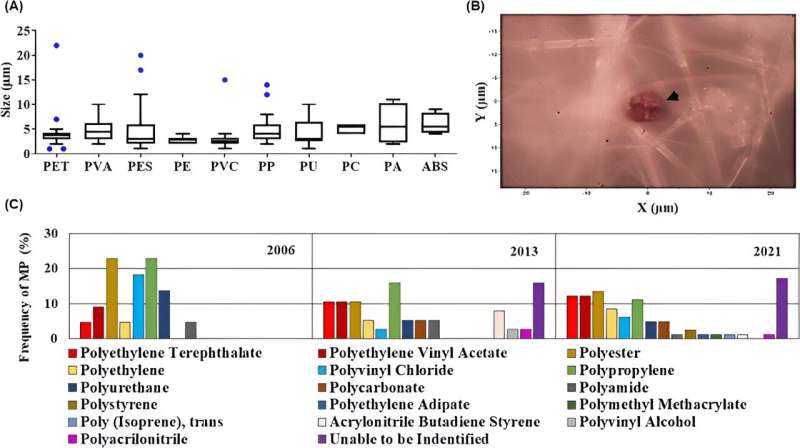This article has been reviewed according to Science X's editorial process and policies. Editors have highlighted the following attributes while ensuring the content's credibility:
fact-checked
peer-reviewed publication
trusted source
proofread
Rise of microplastics discovered in placentas of Hawaiʻi mothers

A placenta (commonly known as the "afterbirth" or "ʻiēwe" [ēwe or ʻiewe] in Hawaiian) is a temporary organ which connects the mother to the fetus via the umbilical cord. Its purpose is to deliver nutrients and oxygen to the fetus while serving as a barrier to prevent infections or viruses from entering the developing fetus.
A new study by researchers at the John A. Burns School of Medicine (JABSOM) at the University of Hawaiʻi at Mānoa and Kapiʻolani Medical Center for Women & Children examined placentas donated by women who delivered in Hawaiʻi from 2006 to 2021, and found the presence of microplastic particles in the placenta.
Microplastics are visible to the naked eye, and examples can range from the plastic beads once found in exfoliating soaps, to particles from disintegrating plastic bags, to bits of plastic found in microwavable containers which are then inadvertently consumed by humans.
"We were shocked that these little pieces of plastic were getting across the mom's gut and landing in the placenta," said Dr. Men Jean Lee, an obstetrician and researcher at JABSOM and Kapiʻolani Medical Center. Dr. Lee, Dr. Rodrigo Weingrill and Dr. Johann Urschitz from UH Mānoa's Institute for Biogenesis Research co-authored the research published in Environment International.
The researchers collected and studied 10 placentas in 2006, 2013 and 2021 and found the presence of microplastics grew each year.
- In 2006, 6 of the 10 placentas contained microplastics.
- In 2013, microplastics were found in 9 of the 10 placentas.
- In 2021, researchers found microplastics in all 10 placentas.
"We believe that the plastics may be floating around in food or being inhaled. It's coming through our digestive fluids or lungs, and the particles are getting absorbed through the gut and traveling through the bloodstream, and then somehow collecting in the placenta during pregnancy," Lee said. "The big question is, as it's traveling through the placenta, can it get through the umbilical cord and then to the baby? We don't know that right now."
Link to global plastic production
We know that the rise in microplastics found in the placentas of Hawaiʻi mothers corresponds with the skyrocketing levels of global plastic production.
According to the Journal of Hazardous Materials, more than 6,000 megatons of plastic were produced in 2020. Less than 2,000 megatons were produced in 2000.
Lee believes Hawaiʻi's remote location creates an added dependency on plastic.
"We're the world's most remote population center or island chain. We're 2,300 miles from California and 4,000 miles from Japan," Lee said. "For daily conveniences, we commonly use plastic wrap, plastic containers, plastic bags and single use water bottles."
She suggests Hawaiʻi's location in the center of the Pacific Ocean, tropical climate, and lack of recycling centers can exacerbate how these plastics are disintegrating or breaking down.
"The incineration of garbage, landfills and marine pollution affect our communities. When trash is being burned, dust particles are released, and can spread into the air we breathe," Lee said.
"In fact, we are concerned about how the debris from the recent Lahaina fires may contain microplastics and other chemical toxins in the remains of the fires. Meanwhile, we already know that sunlight, heat and salt can speed up the breakdown of these everyday plastics. I've noticed plastic bags, even shoes, wear out quickly in Hawaiʻi and turn to dust. I never experienced this when I was living back in New York."
Can microplastics enter the fetus too?
Lee and the JABSOM researchers will continue their research, now focused on seeing if the microplastics can pierce the protection of the placenta and enter the fetus before birth.
"We're not trying to scare people," Lee said, but acknowledges there are other questions that still need to be answered.
"What are the sources of maternal microplastics? What are the plastics doing in the mother's body and the placenta? Are they benign, or are they crossing over to the fetal side into the umbilical cord that is connected to the baby? If they are getting to the other side, are they affecting fetal growth and what happens to the baby when he/she grows up?"
More information: Rodrigo Barbano Weingrill et al, Temporal trends in microplastic accumulation in placentas from pregnancies in Hawaiʻi, Environment International (2023). DOI: 10.1016/j.envint.2023.108220




















